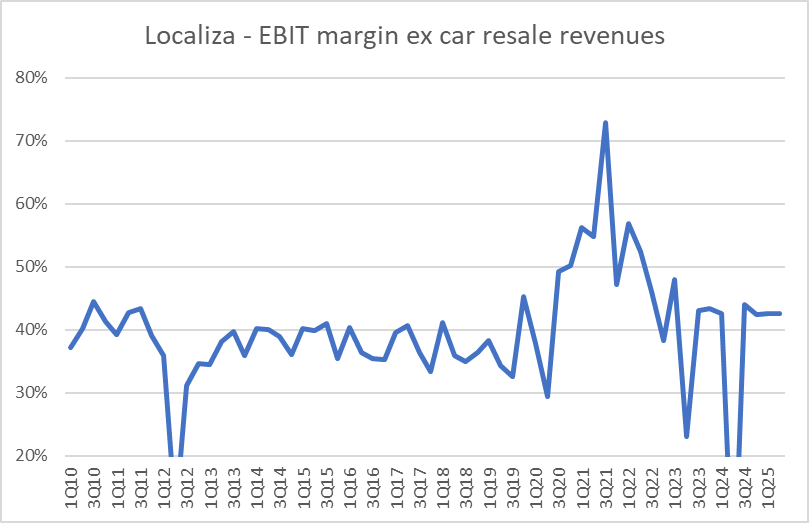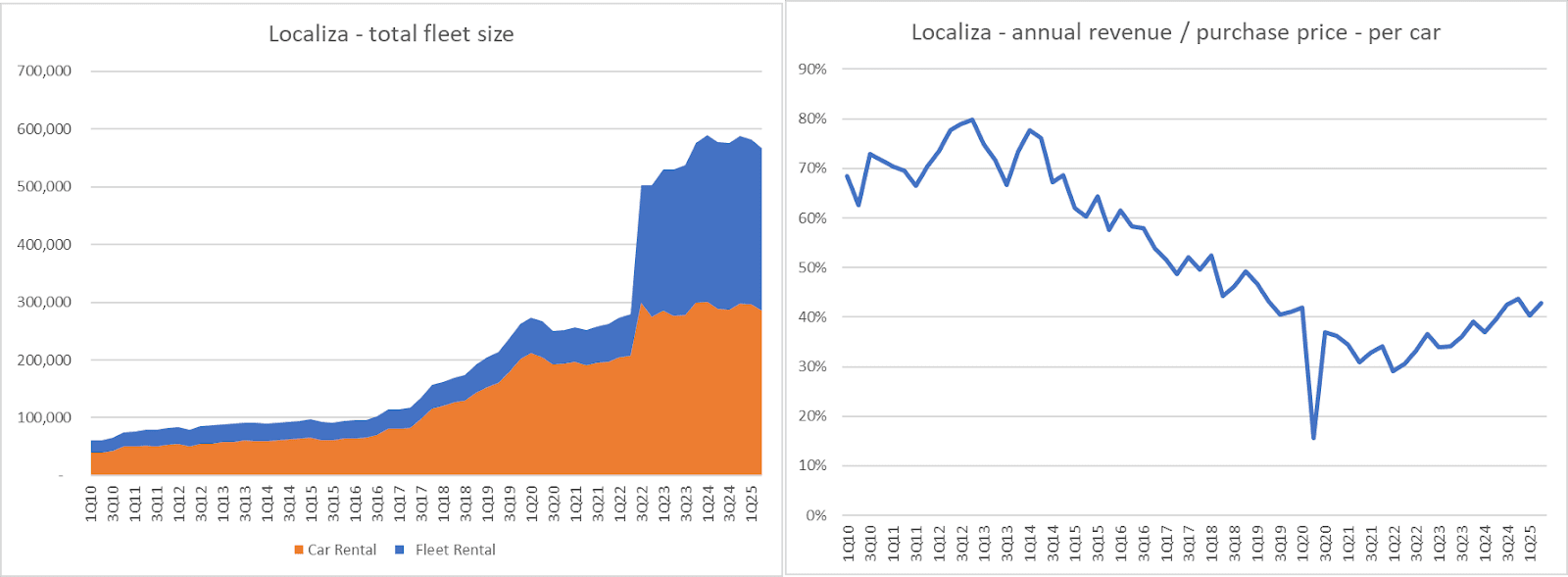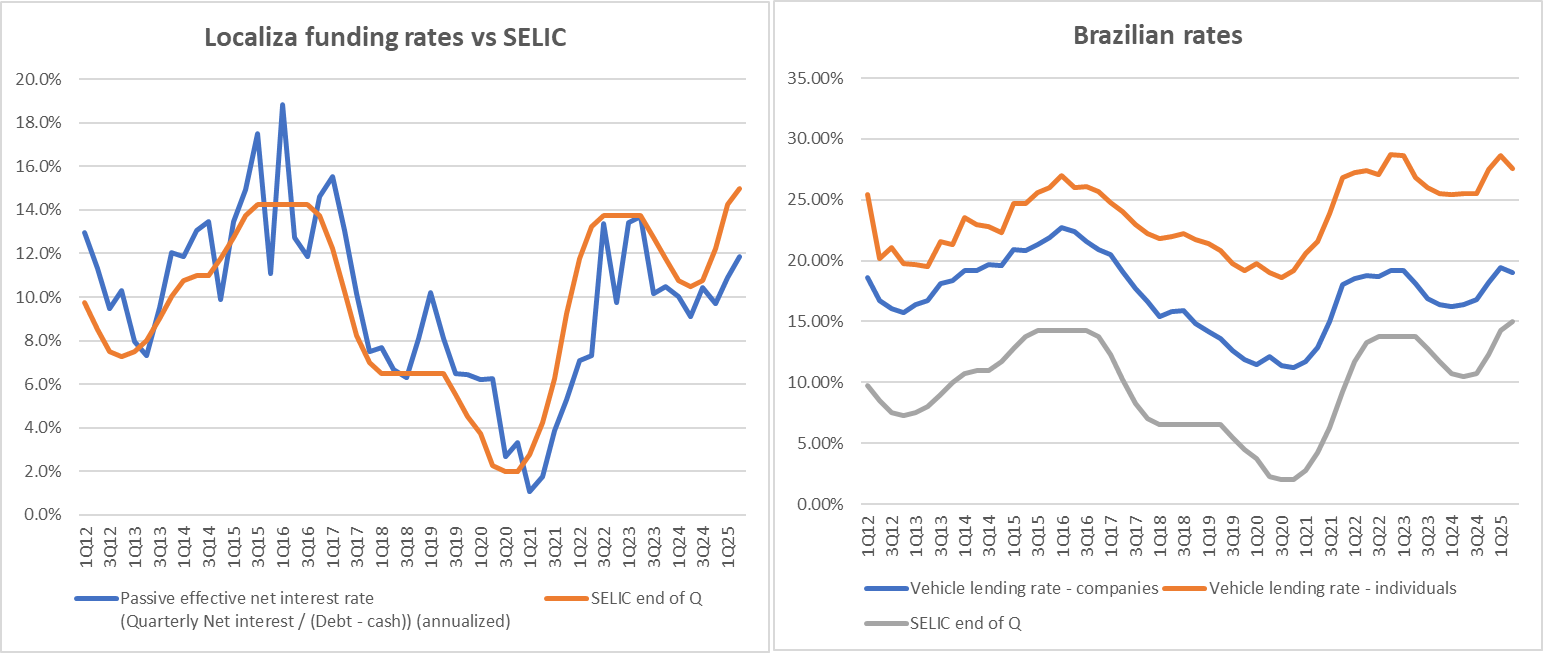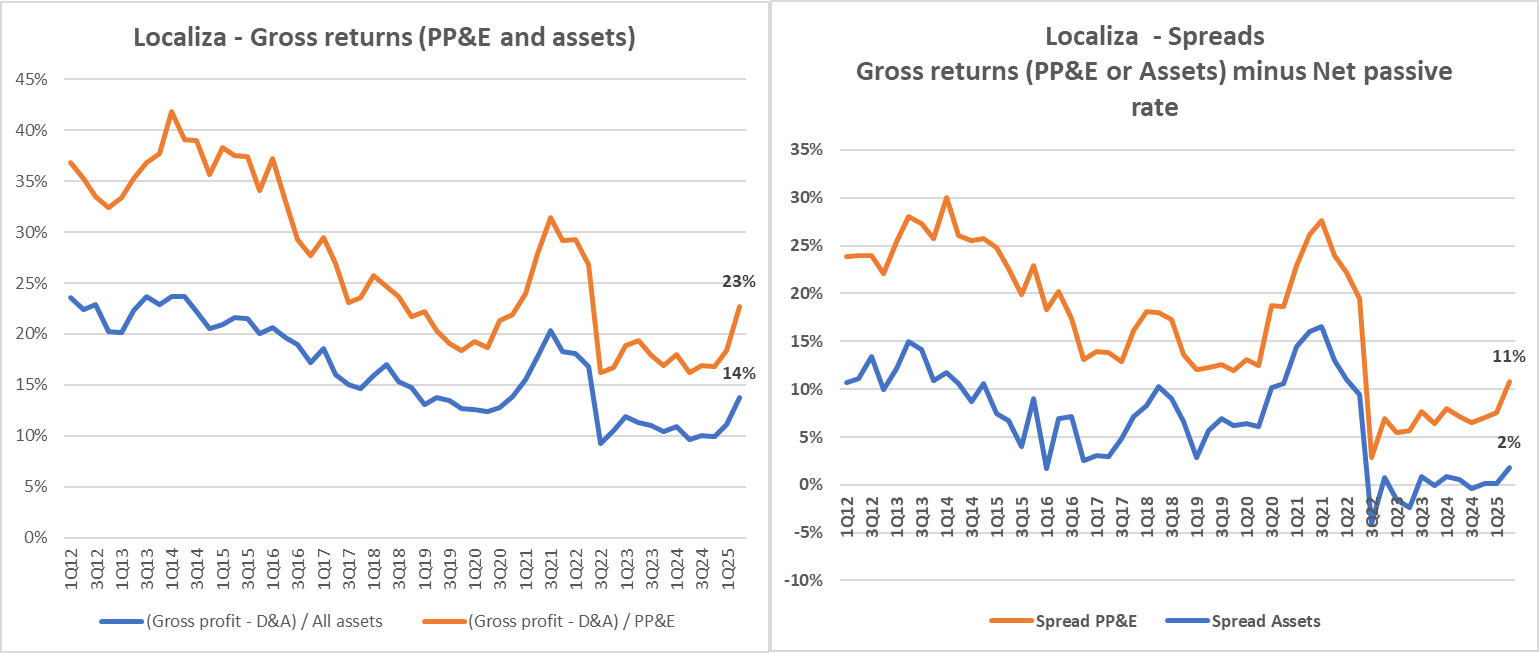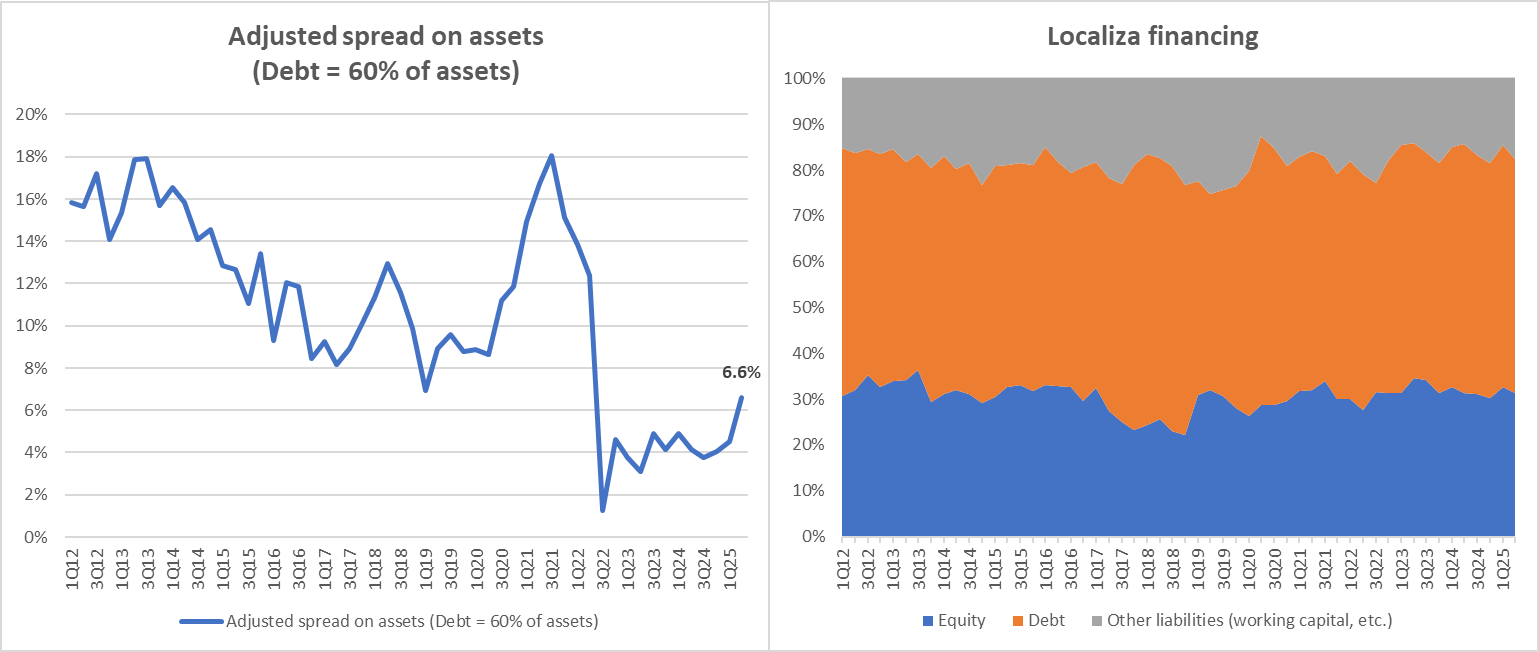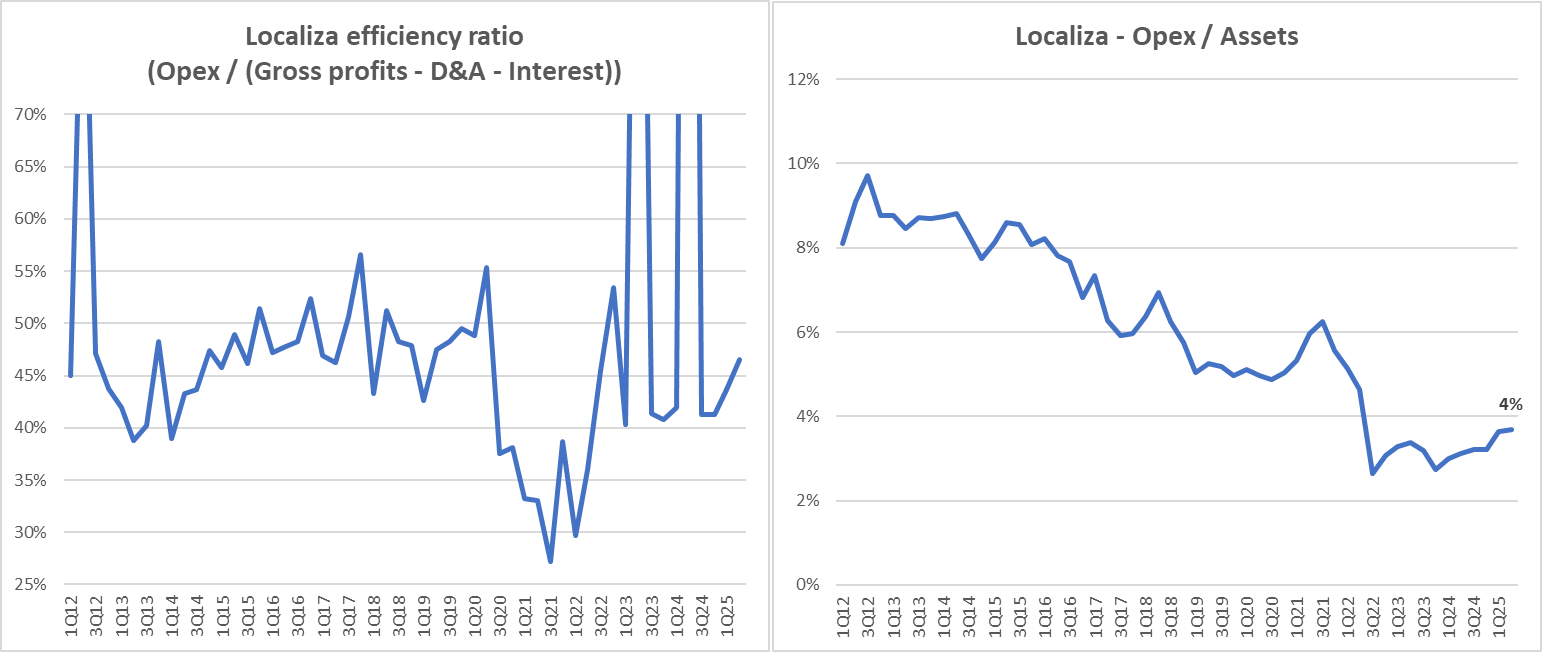Capital-spread businesses: the Localiza example

As part of a review of Brazilian names, I studied a vehicle-renting company called Localiza, recommended by some readers. Significant asset and revenue growth, and EBIT margins of 20% (40% when adjusted), plus the potential, given its large balance sheet, to enjoy the tailwind of lower rates in Brazil. The 30x+ multiples, high for a Brazilian name, are evidence of the confidence of the market.
The company is definitely interesting, especially because of the share it has in the rental market, and even in the overall vehicle market in Brazil (10%+ of all national car purchases in the country).
However, once I dug into the economics of the business, the picture became less rosy. Localiza looks attractive up to operating income, but starts to break on financing. This is no coincidence, given that, because of low asset turnover and high capital requirements, financing is not an afterthought, but rather an operational factor.
Localiza cannot be analyzed like a regular non-financial. Indeed, under careful inspection, it has the characteristics of a bank: low asset turnover, fairly high but profitable leverage, and a ‘spread’ driven business. Even more, it seems that one of Localiza’s competitive drivers is the cost of capital for its customers (the opportunity cost of buying a car with a loan). Restating Localiza’s earnings with a bank-type income statement makes all these drivers fairly clear.
This article explains Localiza’s business model and why it needs to be seen differently than presented on regular financials. It generally paints a more grim picture than the optimism priced into the stock. More broadly, it helps illustrate how to analyze balance-sheet heavy businesses where the main driver is a spread on the cost of capital.
Hope you enjoy it, Vamos La!
Relaed Brazil company articles
Related framework articles
A Brazilian car giant
Localiza Rent a Car ($RENT3.SA), or Localiza for short, is a vehicle renting company in Brazil, with a very small operation in Mexico as well.
Localiza divides its business into two segments, based on the length of the contract: Car is short-term contracts, generally one or a few vehicles, and almost exclusively light vehicles (cars); Fleet is long-term, usually longer than a year contracts, renting more vehicles, and including vehicles other than cars, like trucks, or logistics vans.
Localiza is a large player in the industry, accounting for 11% of light vehicle purchases in Brazil, and has a 47% market share in rentals and a 35% share in Fleet. Today, Localiza has more than 600 thousand vehicles, or almost 1% of all vehicles in Brazil. That makes for a large balance sheet of about R$80 billion, and a very slow asset turnover of less than 0.25x (not considering vehicle sales as revenues).
40% EBIT margins in vehicle renting?
Vehicle renting is a competitive, commoditized business, where most competitors share similar costs (vehicles, financing, real estate, labor), and that is also balance sheet heavy.
Commoditized businesses can earn a differentiated return by cost-leadership, by being the best in all sorts of minutiae about where to locate a store, when to run services, which vehicles to operate, etc. Scale can also provide advantages, via better negotiation terms with OEMs or cheaper financing, mainly.
Considering this, it seems strange that Localiza sports a 20% EBIT margin, which reached 35% during peak shortage periods in 2021. Furthermore, the company’s EBIT margin is depressed by recording as revenues the resale of used vehicles at 0 gross profit (they are basically resold at depreciated value, or impaired if not). This resale operation accounts for more than 50% of the company’s revenues, implying the renting business EBIT margins are 40%+, even after accounting for depreciation just the same.
Localiza is a bank
How can that be? Well, my thesis is that the income statement presented by Localiza, although correct from an accounting perspective, if not reflective of Localiza’s business. The reason is that, at the core, Localiza is a bank, and banks do not show revenues, CoGS, operating income, financing, taxes, net. Rather, they start from financing, and then to other expenses. When we ‘convert’ Localiza’s income statement to that of a bank, it all makes sense.
Starting with demand, pricing and competition, I find that Localiza’s pricing is capped by vehicle loan interest rates in Brazil. This all comes from the opportunity cost for someone that rents cars regularly (or in the case of fleet, for elongated periods). Owning a car has two cost components: depreciation and opportunity cost. Depending on the financing these will take two forms:
If a car is financed by equity, depreciation is a non-cash cost, but the car will eventually get resold for a lower price than purchase, therefore the equity does get cut. The opportunity cost is the interest rate one could have earned by keeping the equity invested in a safe asset. Therefore, for people with equity, D&A + the country’s rate is approximately what they should be willing to pay for a rental (again, we are not talking about some folks going on vacations, but rather heavy renters).
If a car is financed by debt, depreciation is a non-cash cost but is similar to principal amortization (depending on the amortization schedule the timing can change but at maturity they should, ideally, coincide). The opportunity cost becomes a passive rate that one pays on the loan. Therefore, for a debt-financed customer, their ‘cap’ in price should be approximately the amortization + interest schedule on a car loan.
Of course this will not be the calculus in all of the customers heads, and we are not considering a lot of friction and scalable costs where Localiza can make a difference. However, the large and more professional the client, the more he will think about these factors when considering whether to rent / buy with equity / buy with a loan.
And indeed, we find evidence of this. The charts below show Localiza’s gross profit (to avoid accounting for the resale of vehicles) minus depreciation (accounting for the ‘principal repayment’ if debt financing, or equity loss if equity financed), over the average value of the fleet of vehicles, for each segment, and for the aggregate business in the last chart. It compares this with the active lending rates for vehicles in Brazil for individuals (Rental) and companies (Fleet).
We can see that Localiza’s pricing on top of depreciation is very similar to the active rates in banks for vehicle loans. Further, the gap between the rates and Localiza’s pricing has decreased over time, arguably as the market becomes more competitive, but also because Localiza has expanded, potentially needing to pick into less profitable corners of the markets. This is also fairly evident and coincident when we observe annual revenue as a percentage of purchase price, per car.
So far, this explains the active rate in banking, but what about the passive rate? Similar to a bank, Localiza can finance itself at close to the reference rate in Brazil (SELIC, left hand chart). As seen in the right hand chart, lending rates to vehicles in the Brazilian financial market move along with SELIC too.
This, in principle, would make for a fairly good business. SELIC is about 15% today, and the active rates on car loans are closer to 20% for companies and 30% for individuals.
However, we still need to remove other expenses. First off, we need to consider that Localiza does not only own cars. We compared the ‘rate’ earned on cars above, because that is what the customer is approximately thinking about. However, Localiza requires other assets, including working capital, repair shops, etc. Historically, cars have been approximately 60/70% of Localiza’s asset base. When we consider all assets that need to be financed, the ‘gross return’ (gross profit - D&A) almost halves.
From above, we can already observe that the ‘spread’ earned by Localiza on all of its assets has been close to MSD for most of its history, climbed to more than 10pp during the 2021 shortages and post-pandemic boom, and is not closer to LSD (the big fall seen in many charts comes from the merger with Locamerica in 2022). If it were fully financed by debt, the company would not earn any net interest income.
However, debt is only 60% of the company’s assets, therefore allowing the company to earn income via equity and other financing (net negative working capital). The company’s financing has been surprisingly stable over time, and in calls Localiza has explained that it expects to maintain net debt in the range of 50/60% of its fleet value. When we consider financing with 60% debt, the spread on assets is closer to HSD historically, with current figures around MSD.
From the ‘net interest income’, we need to remove OpEx, which has moved down along with the gross return on assets (right hand), but has remained approximately flat when we model it as an ‘efficiency ratio’ (left hand). I cannot explain why OpEx is not more leverageable, except for the short period in 2021 when the return on assets was much higher. I can understand why it does not lever with asset size (most of the expenses probably don’t scale well), but I can’t understand why it does not lever with the spread on assets.
Napkin modelling
Using the thesis above, what can we expect for Localiza?
I would not expect, so far, that their spreads on all assets (100% debt) climb above LSD, as the company integrated Locamerica almost 3 years ago. It is possible, however, than in the high-rate Brazilian world of 2021/25, pricing becomes more tight, because everyone is more aware of the cost of capital. Potentially, lower rates could help the company expand its spreads.
Given that spreads over asset returns are tight, I do not think the company should level more, and management has indicated they do not have plans to do so. If the spread was higher, the company could lever more to increase returns on equity, but that is not the case today, or in the foreseeable future.
On a structure with 60% debt to assets, and 60% cars to assets, the company earns a 7% spread today, after financing costs, and before OpEx. If we consider that OpEx is 45% of the net spread, then the pre-tax spread is 3.15%. On an asset base of approximately R$80 billion, this implies R$2.5 billion, and R$1.75 billion after taxes.
Compared to this, the current market cap of R$46 billion seems excessive. The bullish stance can be justified if one believes the company can expand the spread to approximately 9%, while keeping OpEx at 4% of assets. Under this 5% pre-tax spread scenario the company would generate R$4 billion in net income. I do not think this is very tenable, at least from a historical perspective. The trend so far has been for commoditization, not margin expansion.
Lessons for similar capital-heavy businesses
From the Localiza example, we can obtain a few takeaways about businesses with similar characteristics. Very generally, this includes any business with large capital requirements (low turnover of assets) and high leverage, whether measured as assets/equity or debt/equity. More specifically, businesses offering a commoditized product (often in leasing), where customers face a ‘rent-or-buy’ decision.
Analyzing these businesses purely on an operational basis does not make a lot of sense, because financing is an operational factor. Financing is both a determinant of competition, and a core ‘raw material’ for the business. Localiza has 40% EBIT margins, and yet it earns a very low spread on its capital (versus debt).
Financing therefore becomes a competitive factor. Good decisions in terms of locking in cheap debt or expanding low-cost capital (for instance, via net negative working capital) can be more important than many traditional ‘operational’ factors.
On the income statement, we should treat financing costs as one of the first items after revenue, just like banks do. Indeed, revenues could even be considered net of financing. All efficiency or turnover metrics should then be calculated over these net revenues. For example, for Localiza, SG&A over revenues or over assets shows a leveraging trend, but SG&A over income net of financing shows a very flat trend over more than 10 years.
We should also confirm that the business has historically generated (and can reasonably be expected to generate in the future) an operational return on assets that is higher than its cost of debt. If that is not the case, then it should delever, as debt is destroying value. This is not the case of Localiza (although the spread is very small and shrinking secularly), but other companies might struggle with this. A company whose operational returns on assets are lower than the interest rate on its debt, and that is also adding leverage, is a sure recipe for trouble.
Finally, we should study how the cost of capital in the company’s customer market determines the pricing capacity of the company itself. Is the company long or short duration? That is: does it tend to earn more when rates rise or when they fall? And how long does it take for the business to reach a new equilibrium after rates move?
Hopefully, these help in future company analysis. Cheers






